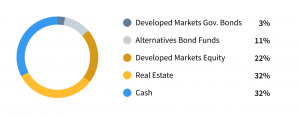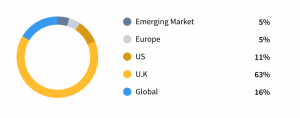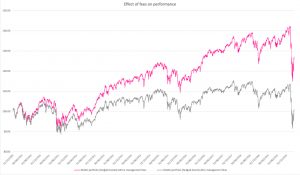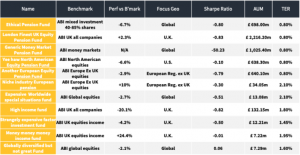One thing most of us have plenty of right now is free time. Countries across the world being in varying states of lockdown means that millions of people are finding ways to fill their days. Now is, in many ways, an ideal opportunity to tackle all the life admin tasks we deferred when the rest of our life wasn’t on hold.
An area which might fall into this category for a lot of people is personal finances. Particularly when saving for the long term future, it can be easy to put off assessing your investments – poring through the numbers can be time-consuming at best.
We see this as a prime opportunity to get your personal finances in order. All investors should be regularly reviewing their assets to make sure they’re getting the most from their money, maintaining the best combination of risk and reward to reach their financial goals.
Here are the key things to think about when getting your investments in order.
How are your assets allocated?
As many people do, holding investments across a number of different providers can make it difficult to get a real handle on what your asset allocation picture looks like.
We have seen countless investment portfolios made up from a number of different providers with no joined-up thinking underpinning them. This can lead to investment portfolios that are everything from cripplingly cautious to wildly volatile, extremes that investors themselves are often unaware they’re leaning into.
Having the right asset allocation is the most important factor in achieving your goals. Different goals across different time frames require different allocations – getting this wrong can be costly.
Diversification is another key tool for investors to ensure their portfolios are robust. When building a broad picture of your asset allocation it’s important to evaluate how well-diversified you are not only across different asset classes but also different regions. Below is an example of the kind of portfolio breakdowns that highlight potential areas of concern to an investor.


As you can see, the first portfolio is heavily concentrated on real estate and has a large proportion of cash. The second is overwhelmingly focused on UK markets – these are all imbalances that an investor might want to rectify to fine-tune their portfolios. With funds allocated across different providers, a client is often unaware of the broader picture of the spread of their investments and these overlaps can be missed.
This is where that overview of the bigger picture can really come in handy. Investors should have an idea of the overall risk level of their assets, as well as ensuring there is as little overlap as possible. Now is the time to build a clearer picture of your asset allocation – the result might surprise you.
Have you reviewed your costs?
Another key thing for investors to consider when reviewing their portfolios and providers is costs. With investments spread across a number of providers, it’s important to know not just what you’re spending on fees but also what those fees represent as a percentage of your returns.
The graph below displays the growth of a portfolio, in this case made up of 60% MSCI world hedged ETF and 40% Barclays Aggregate bond index hedged ETF. The performance includes the fee rate charged by the funds themselves but when subject to a management fee rate of 2% from the advisor or platform, the difference in actual returns can be stark. This leads eventually to a disparity in the growth of the portfolio, as seen below.

Due to the nature of compounding, the disparity in returns gets greater the longer the time frame.
Having your investments managed by advisors with high fees can seriously eat into your returns. The same goes for investments spread across multiple providers, where costs can add up. Any review of an investors portfolio should include a deep look at the costs to ensure you’re getting value for money on your investments.
Are your investments really performing?
Another question to consider is how well your investments have been performing, both historically and throughout the recent turbulence. Many investors will only concern themselves with the fundamental figures, the amount their investments have grown over time.
There can be a lot of value in digging deeper. A full breakdown of the funds that make up an investment portfolio can provide information that is obscured when the stack is taken as a whole. Individual performance, geographical focus, return, fees – these are all important things to be aware of when assessing your own portfolio.

Above is an example of an investment portfolio spread across numerous providers, with the performance of each fund measured against the benchmark earmarked by the funds themselves. As mentioned above, while funds can seem to be performing well in an absolute sense, they may actually be performing worse than their peers in the same category. This is why performance against the benchmark is an important metric.
In cases like these, investors are often allocated funds by an advisor but are unaware of the nuts and bolts behind each one. For example, just over half of the funds listed take over 1% in fees (TER), with some even charging over 2% (as seen above this can be very detrimental in the long run). Despite this, many are not beating their benchmarks and some are significantly underperforming against them. Portfolios made up of too many underperforming assets can perform far more effectively with just a few tweaks.
We can do the work for you
Analysing this information is time-consuming. Even under government-advised lockdown, many investors simply won’t have the time to pull all this data together and create a detailed, actionable report. This is where we can help.
We’ll help you to assess any investments you hold in and outside of Moneyfarm, based on their allocation, their performance and their costs. It’s a free, impartial service with no obligation that can help you put your investments in perspective and ensure they align with your goals for the future.
All we need to create a full, detailed report of your investment holdings is the breakdowns across your different accounts. We will assess their risk profile, their performance comparison against the benchmark and their spread to create a comprehensive view of your assets.
Our investment advisers will also be available to talk through your retirement fund, your various tax-free allowances, your current inheritance tax position and more. So please feel free to get in touch.

Chris is passionate about blending technology and human expertise to help people make better investment decisions to secure their financial future. With a keen interest in the impact macro economics has on investments, Chris is a Senior Investment Consultant at Moneyfarm.





